Learning Journal for HLTENN006 Apply principles of wound management in the clinical environment
Complete all tasks detailed in the following pages and submit with the assessment cover sheet.
31 Pages7724 Words254 Views
Added on 2023-04-25
About This Document
This learning journal covers various topics related to wound management such as chain of infection, hand hygiene, types of wounds, wound assessment, and more. It is a part of the assessment task for Diploma Nursing HLT54115 unit HLTENN006.
Learning Journal for HLTENN006 Apply principles of wound management in the clinical environment
Complete all tasks detailed in the following pages and submit with the assessment cover sheet.
Added on 2023-04-25
ShareRelated Documents
Assessment Cover Sheet
Qualification: Diploma Nursing HLT54115
Unit of Competency: HLTENNOO6
Assessment Task: Learning Journal
Assessment Date/Submission date: 17/11/2018 Journal 4(1,2,3,6,7)
General Instructions:
Complete all tasks detailed in the followingpages
Fill in this assessment cover sheet and submit with your completed assessment task
Sign thedeclaration
Submit the completed tasks within the duedate
STUDENT ORGINALITY DECLARATION: Please tick to indicate that you understand the
following statements: I declare that:
The attached assessment is my own work, except where I have cited the
originalsources.
For the purposes of assessment, I give the assessor of this assessment permission to:
Reproduce my work and provide a copy to another member of staff,and
Validate the assessment for its authenticity which may include communicating a
Student Name: Bindu Kharel
Student ID: 804453555
Student Signature:
Date: 19/11/2018
Assessment Outcome:
For UOC being assessed by multiple assessment activities, each activity will
be reported as Satisfactory or Not Satisfactory
[Satisfactory] [NotSatisfactory]
Resubmission(RS)For UOC being assessed for the final result it will be reported as AC
(Competent) or NC (Not yet competent)
[Competent-AC] [NotYetCompetent-NC]
Resubmission(RS)Assessor
Name/
Signature:
Date:
Assignment extension request
A request must be made in writing to the head teacher prior to the assignment due date of submission with
reasonable explanations concerning delay. If granted the late submission is limited to a maximum of one (1)
week from the original submission date. No assignment will be accepted after the seven (7) day period. Non-
submission of the assignment on the due date will result in failure of that unit.
Qualification: Diploma Nursing HLT54115
Unit of Competency: HLTENNOO6
Assessment Task: Learning Journal
Assessment Date/Submission date: 17/11/2018 Journal 4(1,2,3,6,7)
General Instructions:
Complete all tasks detailed in the followingpages
Fill in this assessment cover sheet and submit with your completed assessment task
Sign thedeclaration
Submit the completed tasks within the duedate
STUDENT ORGINALITY DECLARATION: Please tick to indicate that you understand the
following statements: I declare that:
The attached assessment is my own work, except where I have cited the
originalsources.
For the purposes of assessment, I give the assessor of this assessment permission to:
Reproduce my work and provide a copy to another member of staff,and
Validate the assessment for its authenticity which may include communicating a
Student Name: Bindu Kharel
Student ID: 804453555
Student Signature:
Date: 19/11/2018
Assessment Outcome:
For UOC being assessed by multiple assessment activities, each activity will
be reported as Satisfactory or Not Satisfactory
[Satisfactory] [NotSatisfactory]
Resubmission(RS)For UOC being assessed for the final result it will be reported as AC
(Competent) or NC (Not yet competent)
[Competent-AC] [NotYetCompetent-NC]
Resubmission(RS)Assessor
Name/
Signature:
Date:
Assignment extension request
A request must be made in writing to the head teacher prior to the assignment due date of submission with
reasonable explanations concerning delay. If granted the late submission is limited to a maximum of one (1)
week from the original submission date. No assignment will be accepted after the seven (7) day period. Non-
submission of the assignment on the due date will result in failure of that unit.
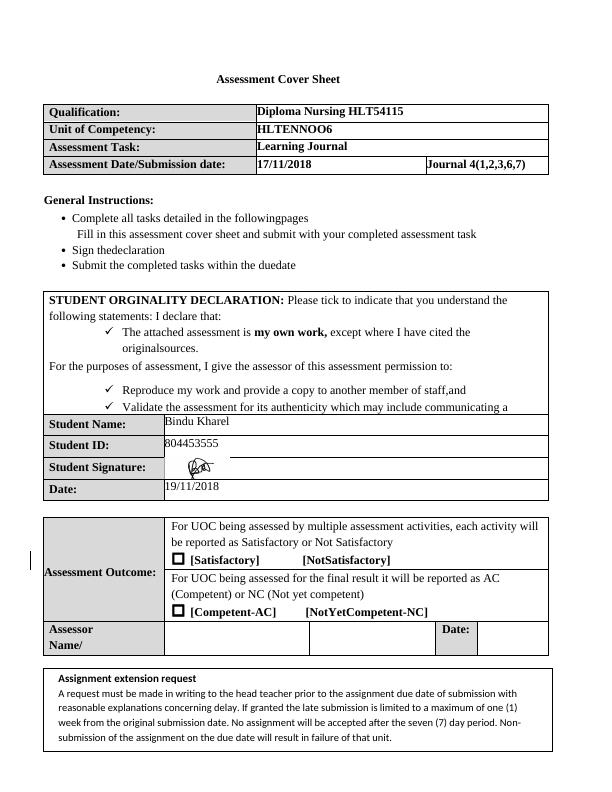
HLTENN006 V4 March 2017
Bindu
You will need to resubmit this assignmentz9questin 1 & 3) by 21 January. I would recommend that you go
to Foundation studies before resubmitting.
This was your second attempt. You will need to email Ros to reapply for this Unit.
Any questions please do not hesitate to contact me. I am on leave until January the21 January.
Thanks Bindu.
Joanne Clarke
Bindu
You will need to resubmit this assignmentz9questin 1 & 3) by 21 January. I would recommend that you go
to Foundation studies before resubmitting.
This was your second attempt. You will need to email Ros to reapply for this Unit.
Any questions please do not hesitate to contact me. I am on leave until January the21 January.
Thanks Bindu.
Joanne Clarke
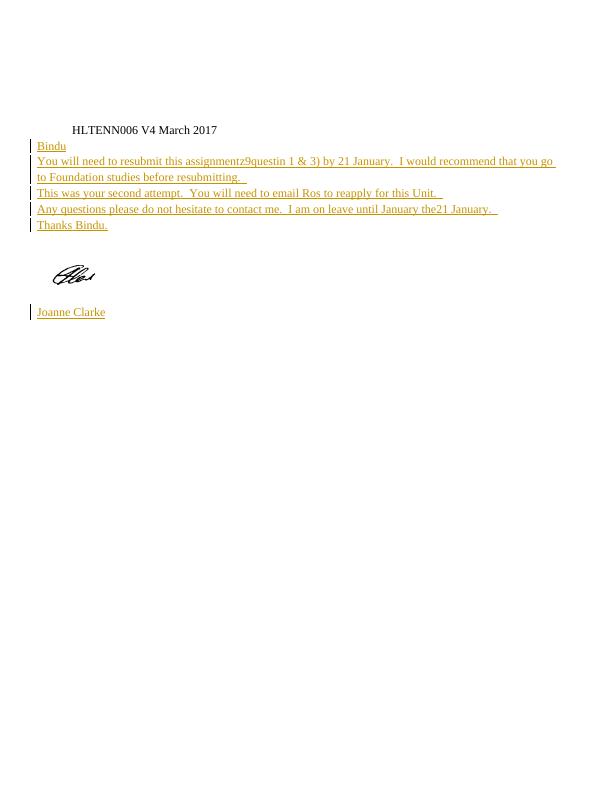
Kharel.bindu.20182.HLTENN006.LEARNING JOURNAL
LearningJournal
HLTENN006 Apply principles of wound management in the clinical environment
Contents
Journal Activity 1: Chainofinfection...............................................................................................3
Journal Activity 2:Handhygiene......................................................................................................4
Journal Activity 3: Typesofwounds.................................................................................................5
Journal Activity 4: Wound assessmentcasestudy............................................................................6
Journal Activity 5: Woundassessmenttools.....................................................................................9
Journal Activity 6: Advantages and disadvantages ofassessmenttools.........................................10
Journal Activity7:Drains................................................................................................................11
Journal Activity 8: Typesofdressings............................................................................................12
Journal Activity 9: Principles of complexwoundmanagement......................................................13
Kharel.Bindu.20182.HLTENNOO6.Learning Journal
LearningJournal
HLTENN006 Apply principles of wound management in the clinical environment
Contents
Journal Activity 1: Chainofinfection...............................................................................................3
Journal Activity 2:Handhygiene......................................................................................................4
Journal Activity 3: Typesofwounds.................................................................................................5
Journal Activity 4: Wound assessmentcasestudy............................................................................6
Journal Activity 5: Woundassessmenttools.....................................................................................9
Journal Activity 6: Advantages and disadvantages ofassessmenttools.........................................10
Journal Activity7:Drains................................................................................................................11
Journal Activity 8: Typesofdressings............................................................................................12
Journal Activity 9: Principles of complexwoundmanagement......................................................13
Kharel.Bindu.20182.HLTENNOO6.Learning Journal

Kharel.bindu.20182.HLTENN006.LEARNING JOURNAL
Journal Activity 1: Chain of infection
Using relevant resources, research the ‘Chain of Infection’. Summarise your readings using the
headings in the table below.
Main Points Development of an infection occurs in a cycle that depends on the
presence of all the following elements:
Infectious agent
(Pathogen)
Infectious agents refers to the pathogen or germ that is responsible for
causing the disease. Viruses, fungi, bacteria and parasites may act as an
infectious agents. Although some pathogens are associated with the
wellbeing of the body. They causes diseases only when, they leave their
actual place and transmit to the other place of our body. Infectious agents
are any microorganisms that can cause a disease such as virus, bacteria,
parasites etc. Ability to grow, enter tissue, cause disease are some of the
Reservoir
Reservoir refers to the habitat in which the infectious agents normally
live, grow and multiply. Reservoir may include animals, environment
and the human. However, it is not fixed that, always the pathogen will
transmit to the host from the reservoir. The small pox virus has the
human reservoir. Disease can be transmitted from animal to human as
well, Disease like Ebola can be transmitted to human from the animal.
Soil, water are the example of environmental reservoir (CDC,
2019).Reservoir is the place where microorganisms resides, thrives and
Portal of ExitMode of
escape
The term refers to the path in which the pathogen leaves its host. For
example, influenza virus’s portal of exit is the respiratory tract.Mode of
escape is the place where the microorganisms leaves the reservoir, such
as the respiratory tract (nose, mouth), intestinal tract(rectum via stool),
urinary tract, blood and other body fluids. (RCN.2016)
Mode of
transmission
The pathogen may transmit to its host from the reservoir by many ways.
They mainly transmit via direct and indirect ways. The pathogen may
transmit via direct contact and it is the direct mode of transmission. In an
indirect mode, the virus can be transmitted through air, vehicle and
vector (CDC, 2019).Mode of transmission is the means by which an
Portal Mode of
entry
Portal of entry is the manner in which a pathogen enters into the host’s
body. E.g- Skin is the portal of entry for hookworm.Mode of entry are
those opening where an infectious host enters the host’s body such as
mucus membrane, open wounds, or tubes inserted in body cavities like
urinary catheters or feeding tubes.(RCN.2016)
Susceptible host
Susceptible host is that particular host who has lesser immunity or some
genetic alteration and as a result they may safe to a particular pathogen or
may more vulnerable to the pathogen. Sickle cell anemia people are
partially protected from malaria (CDC, 2019).Susceptible host is a person
who is at risk for developing an infection from the disease. Factors
Kharel.Bindu.20182.HLTENNOO6.Learning Journal
Journal Activity 1: Chain of infection
Using relevant resources, research the ‘Chain of Infection’. Summarise your readings using the
headings in the table below.
Main Points Development of an infection occurs in a cycle that depends on the
presence of all the following elements:
Infectious agent
(Pathogen)
Infectious agents refers to the pathogen or germ that is responsible for
causing the disease. Viruses, fungi, bacteria and parasites may act as an
infectious agents. Although some pathogens are associated with the
wellbeing of the body. They causes diseases only when, they leave their
actual place and transmit to the other place of our body. Infectious agents
are any microorganisms that can cause a disease such as virus, bacteria,
parasites etc. Ability to grow, enter tissue, cause disease are some of the
Reservoir
Reservoir refers to the habitat in which the infectious agents normally
live, grow and multiply. Reservoir may include animals, environment
and the human. However, it is not fixed that, always the pathogen will
transmit to the host from the reservoir. The small pox virus has the
human reservoir. Disease can be transmitted from animal to human as
well, Disease like Ebola can be transmitted to human from the animal.
Soil, water are the example of environmental reservoir (CDC,
2019).Reservoir is the place where microorganisms resides, thrives and
Portal of ExitMode of
escape
The term refers to the path in which the pathogen leaves its host. For
example, influenza virus’s portal of exit is the respiratory tract.Mode of
escape is the place where the microorganisms leaves the reservoir, such
as the respiratory tract (nose, mouth), intestinal tract(rectum via stool),
urinary tract, blood and other body fluids. (RCN.2016)
Mode of
transmission
The pathogen may transmit to its host from the reservoir by many ways.
They mainly transmit via direct and indirect ways. The pathogen may
transmit via direct contact and it is the direct mode of transmission. In an
indirect mode, the virus can be transmitted through air, vehicle and
vector (CDC, 2019).Mode of transmission is the means by which an
Portal Mode of
entry
Portal of entry is the manner in which a pathogen enters into the host’s
body. E.g- Skin is the portal of entry for hookworm.Mode of entry are
those opening where an infectious host enters the host’s body such as
mucus membrane, open wounds, or tubes inserted in body cavities like
urinary catheters or feeding tubes.(RCN.2016)
Susceptible host
Susceptible host is that particular host who has lesser immunity or some
genetic alteration and as a result they may safe to a particular pathogen or
may more vulnerable to the pathogen. Sickle cell anemia people are
partially protected from malaria (CDC, 2019).Susceptible host is a person
who is at risk for developing an infection from the disease. Factors
Kharel.Bindu.20182.HLTENNOO6.Learning Journal
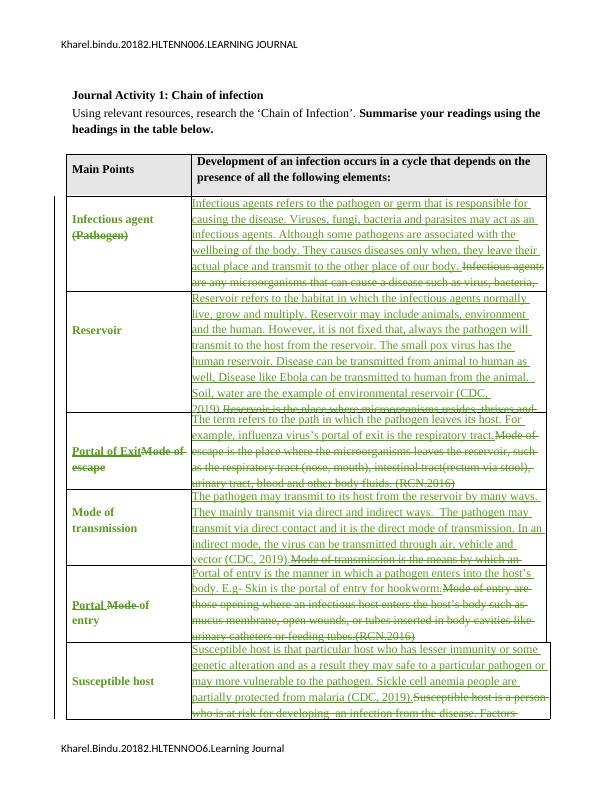
Kharel.bindu.20182.HLTENN006.LEARNING JOURNAL
Journal Activity 2: Hand hygiene
Explain the importance of hand hygiene in relation to best practice in wound management.
Hand hygiene is viewed as one of the most important components of infection control activities. In
the wake of the growing burden of health care associated infections , the increasing severity of
illness and complexity of treatment, superimposed by multi-drug resistant pathogen infections,
health care practitioners are reversing back to the basics of wound management by simple measures
like hand hygiene. There is also a scientific evidence that if hand hygiene is properly implemented,
hand hygiene alone can significantly reduce the risk of cross-transmission of infection in healthcare.
Preventing and managing infection in wound care can often be challenging. In particular, chronic
wounds are almost inevitably going to acquire a collection of various bacteria, likely to include
staphylococcus aureus and pseudomonas, along with a mixture of gram-positive and gram-
negative bacteria. The most fundamental element to any infection control policy is effective hand
washing, both before and after dealing with any patient or client. Patients are generally unwell,
recovering from an operation or may have decreased immunity leaving them at increased risk of
infection from germs. Our main motive is to prevent patients from infection . One of the easiest and
most effective ways to reduce infection is for all staff, patients and visitors to practice good hand
hygiene. Proper hand hygiene is the single most important, simplest, and least expensive means of
reducing the prevalence of HAIs and the spread of antimicrobial resistance. Several studies have
demonstrated that adherence to hand hygiene practices has significantly reduced the rates of
acquisition of pathogens on hands and has ultimately reduced the rates of HAIs in a hospital.
Improper hygiene doesn’t just leave us with a greater risk of contracting infections. Hand hygiene,
has great impact on patient's pre and post-surgical process. Hence it can be considered as one of the
best technique in relation to the wound management. (Indian journal of medical research.Nov,2011)
Kharel.Bindu.20182.HLTENNOO6.Learning Journal
Journal Activity 2: Hand hygiene
Explain the importance of hand hygiene in relation to best practice in wound management.
Hand hygiene is viewed as one of the most important components of infection control activities. In
the wake of the growing burden of health care associated infections , the increasing severity of
illness and complexity of treatment, superimposed by multi-drug resistant pathogen infections,
health care practitioners are reversing back to the basics of wound management by simple measures
like hand hygiene. There is also a scientific evidence that if hand hygiene is properly implemented,
hand hygiene alone can significantly reduce the risk of cross-transmission of infection in healthcare.
Preventing and managing infection in wound care can often be challenging. In particular, chronic
wounds are almost inevitably going to acquire a collection of various bacteria, likely to include
staphylococcus aureus and pseudomonas, along with a mixture of gram-positive and gram-
negative bacteria. The most fundamental element to any infection control policy is effective hand
washing, both before and after dealing with any patient or client. Patients are generally unwell,
recovering from an operation or may have decreased immunity leaving them at increased risk of
infection from germs. Our main motive is to prevent patients from infection . One of the easiest and
most effective ways to reduce infection is for all staff, patients and visitors to practice good hand
hygiene. Proper hand hygiene is the single most important, simplest, and least expensive means of
reducing the prevalence of HAIs and the spread of antimicrobial resistance. Several studies have
demonstrated that adherence to hand hygiene practices has significantly reduced the rates of
acquisition of pathogens on hands and has ultimately reduced the rates of HAIs in a hospital.
Improper hygiene doesn’t just leave us with a greater risk of contracting infections. Hand hygiene,
has great impact on patient's pre and post-surgical process. Hence it can be considered as one of the
best technique in relation to the wound management. (Indian journal of medical research.Nov,2011)
Kharel.Bindu.20182.HLTENNOO6.Learning Journal
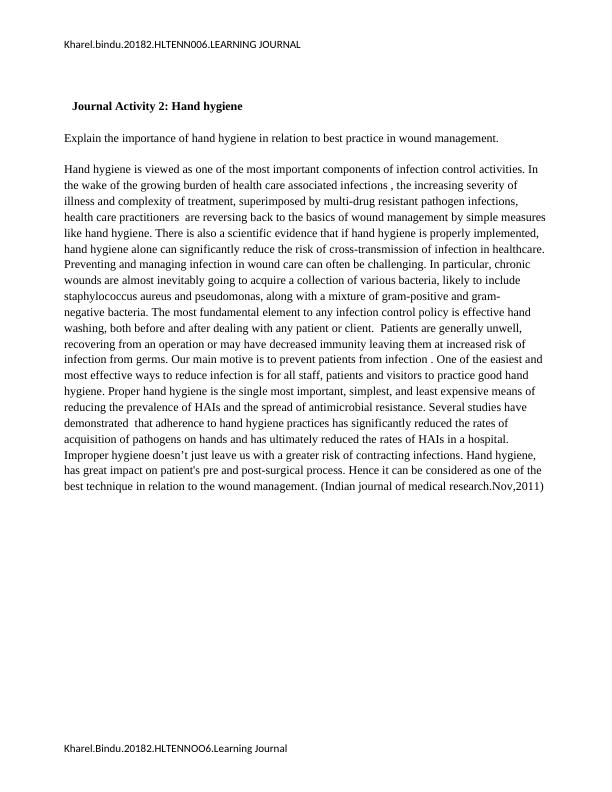
Kharel.bindu.20182.HLTENN006.LEARNING JOURNAL
Journal Activity 3: Types of wounds
Using any relevant textbook, write a short paragraph about each of the following wound types.
Surgical incision
It is the process that is executed during the operation procedure and the incision is due to the cut of
skin and soft tissues.
Traumatic injury
This injury is mainly happened due to life threatening events and it needs immediate medical
treatment as it is associated with the life of the patient (Shier, Butler & Lewis, 2015).
Ulcers
Ulcers is a sore on a mucous membrane or on the skin. It may appear inside or outside of the body.
Long time immobility can also cause ulcers in the skin.
Burns
Burns are associated with the severe skin damage due to hit, cold, electricity and chemical
exposure (Shier, Butler & Lewis, 2015).
Avulsion
It is the partial or complete tearing of the tissue and skin. It is mainly occurred due to violent
accidents, explosions.
Abrasions
It occurs when the skin is scraped by a hard or rough surface. Road rash can be an example (Shier,
Butler & Lewis, 2015).
Amputations
Amputations refers to the surgical removal of any part of the body that is mainly leg or arm of the
body. Amputations can be done due to infection or gangrene of the limb (NHS, 2019)
Graft and Donor site
It is a general surgical procedure in which a skin is removed from the site called donor site and it is
placed in injured area of body. Upper Thigh may be a donor site (Tasmanian Health services,
2019).
Kharel.Bindu.20182.HLTENNOO6.Learning Journal
Journal Activity 3: Types of wounds
Using any relevant textbook, write a short paragraph about each of the following wound types.
Surgical incision
It is the process that is executed during the operation procedure and the incision is due to the cut of
skin and soft tissues.
Traumatic injury
This injury is mainly happened due to life threatening events and it needs immediate medical
treatment as it is associated with the life of the patient (Shier, Butler & Lewis, 2015).
Ulcers
Ulcers is a sore on a mucous membrane or on the skin. It may appear inside or outside of the body.
Long time immobility can also cause ulcers in the skin.
Burns
Burns are associated with the severe skin damage due to hit, cold, electricity and chemical
exposure (Shier, Butler & Lewis, 2015).
Avulsion
It is the partial or complete tearing of the tissue and skin. It is mainly occurred due to violent
accidents, explosions.
Abrasions
It occurs when the skin is scraped by a hard or rough surface. Road rash can be an example (Shier,
Butler & Lewis, 2015).
Amputations
Amputations refers to the surgical removal of any part of the body that is mainly leg or arm of the
body. Amputations can be done due to infection or gangrene of the limb (NHS, 2019)
Graft and Donor site
It is a general surgical procedure in which a skin is removed from the site called donor site and it is
placed in injured area of body. Upper Thigh may be a donor site (Tasmanian Health services,
2019).
Kharel.Bindu.20182.HLTENNOO6.Learning Journal

Kharel.bindu.20182.HLTENN006.LEARNING JOURNAL
References
CDC. (2019). Principles of Epidemiology | Lesson 1 - Section 10. Retrieved from
https://www.cdc.gov/ophss/csels/dsepd/ss1978/lesson1/section10.html
NHS (2019). Amputation. nhs.uk. Available at: https://www.nhs.uk/conditions/amputation/
[Accessed 25 Jan. 2019].
Shier, D., Butler, J., & Lewis, R. (2015). Hole's essentials of human anatomy & physiology. New
York: McGraw-Hill Education.
Surgical incisions
A surgical incision is a cut made through the skin and soft tissue to facilitate an operation or
procedure. Multiple incisions could be made for an operation. Generally, a surgical incision is
made as small and unobtrusive as possible to facilitate safe and timely operating conditions.
(Wounds Australia.2018)
Traumatic injuries
A physical injuries of sudden onset and severity which require immediate medical attention is
known as traumatic injury. The insult may cause systemic shock called “shock trauma”, and may
require immediate resuscitation and interventions to save life and limb. (Wounds Australia.2018)
Kharel.Bindu.20182.HLTENNOO6.Learning Journal
References
CDC. (2019). Principles of Epidemiology | Lesson 1 - Section 10. Retrieved from
https://www.cdc.gov/ophss/csels/dsepd/ss1978/lesson1/section10.html
NHS (2019). Amputation. nhs.uk. Available at: https://www.nhs.uk/conditions/amputation/
[Accessed 25 Jan. 2019].
Shier, D., Butler, J., & Lewis, R. (2015). Hole's essentials of human anatomy & physiology. New
York: McGraw-Hill Education.
Surgical incisions
A surgical incision is a cut made through the skin and soft tissue to facilitate an operation or
procedure. Multiple incisions could be made for an operation. Generally, a surgical incision is
made as small and unobtrusive as possible to facilitate safe and timely operating conditions.
(Wounds Australia.2018)
Traumatic injuries
A physical injuries of sudden onset and severity which require immediate medical attention is
known as traumatic injury. The insult may cause systemic shock called “shock trauma”, and may
require immediate resuscitation and interventions to save life and limb. (Wounds Australia.2018)
Kharel.Bindu.20182.HLTENNOO6.Learning Journal
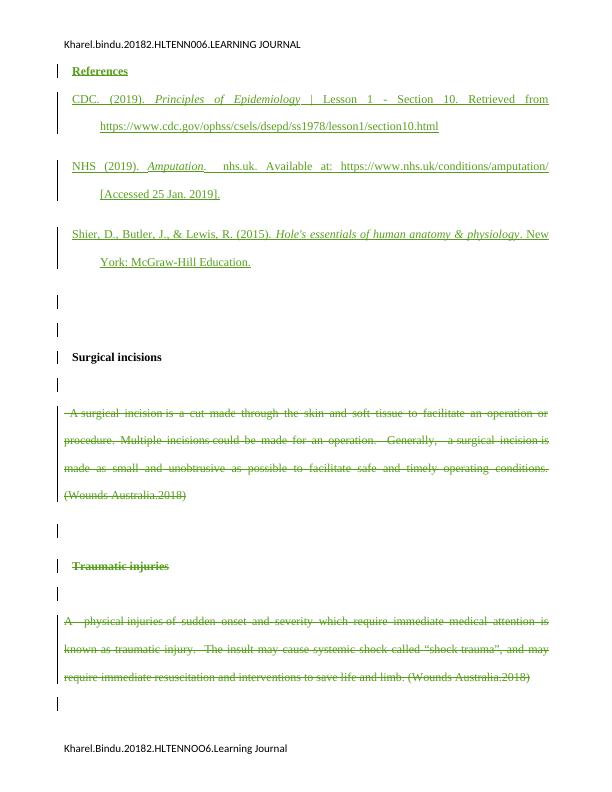
Kharel.bindu.20182.HLTENN006.LEARNING JOURNAL
Ulcers
Ulcers are sores that are slow to heal or keep returning. They can take many form and appear inside
or outside of the body. ABreak in the tissue lining of the stomach is called stomach or gastric ulcer.
Most stomach ulcers are caused by infection with the Helicobacter pylori bacterium or anti-
inflammatory medication, not stress or poor diet as once thought. (Wounds Australia.2018)
Burns
Burn is a type of injury to skin, or other tissues, caused by heat, cold, electricity, chemicals,
friction, or radiation. Most burns are due to heat from hot liquids, solids, or fire. (Wounds
Australia.2018)
Avulsion
Avulsion is an injury in which a body structure is forcibly detached from its normal point of
insertion by either trauma or surgery. (Wounds Australia.2018)
Abrasions/skin tears
An abrasion is a wound caused by superficial damage to the skin, no deeper than the epidermis. It is
less severe than a laceration, and bleeding, if present, is minimal. Mild abrasion , also known as
grazes or scrapes, do not scar or bleed, but deep abrasions may lead to the formation of sca.
Kharel.Bindu.20182.HLTENNOO6.Learning Journal
Ulcers
Ulcers are sores that are slow to heal or keep returning. They can take many form and appear inside
or outside of the body. ABreak in the tissue lining of the stomach is called stomach or gastric ulcer.
Most stomach ulcers are caused by infection with the Helicobacter pylori bacterium or anti-
inflammatory medication, not stress or poor diet as once thought. (Wounds Australia.2018)
Burns
Burn is a type of injury to skin, or other tissues, caused by heat, cold, electricity, chemicals,
friction, or radiation. Most burns are due to heat from hot liquids, solids, or fire. (Wounds
Australia.2018)
Avulsion
Avulsion is an injury in which a body structure is forcibly detached from its normal point of
insertion by either trauma or surgery. (Wounds Australia.2018)
Abrasions/skin tears
An abrasion is a wound caused by superficial damage to the skin, no deeper than the epidermis. It is
less severe than a laceration, and bleeding, if present, is minimal. Mild abrasion , also known as
grazes or scrapes, do not scar or bleed, but deep abrasions may lead to the formation of sca.
Kharel.Bindu.20182.HLTENNOO6.Learning Journal

End of preview
Want to access all the pages? Upload your documents or become a member.
Related Documents
HLTENN003: Perform Clinical Assessment and Contribute to Planning Nursing Carelg...
|18
|4072
|475
HLTENN009 - IMPLEMENT AND MONITOR CARE FOR A.lg...
|10
|1877
|178
Promote Aboriginal and/or Torres Strait Islander cultural safety Assessment Guidelg...
|11
|2863
|100
CHCCSM005 Develop, Facilitate and Review All Aspects of Case Management - Student Assessment Workbooklg...
|26
|8569
|354
CHCCCS019 Recognise and Respond to Crisis Situations - Student Assessment Workbooklg...
|29
|8904
|222
Provide Case Management Supervision - Student Assessment Workbooklg...
|22
|6853
|298
